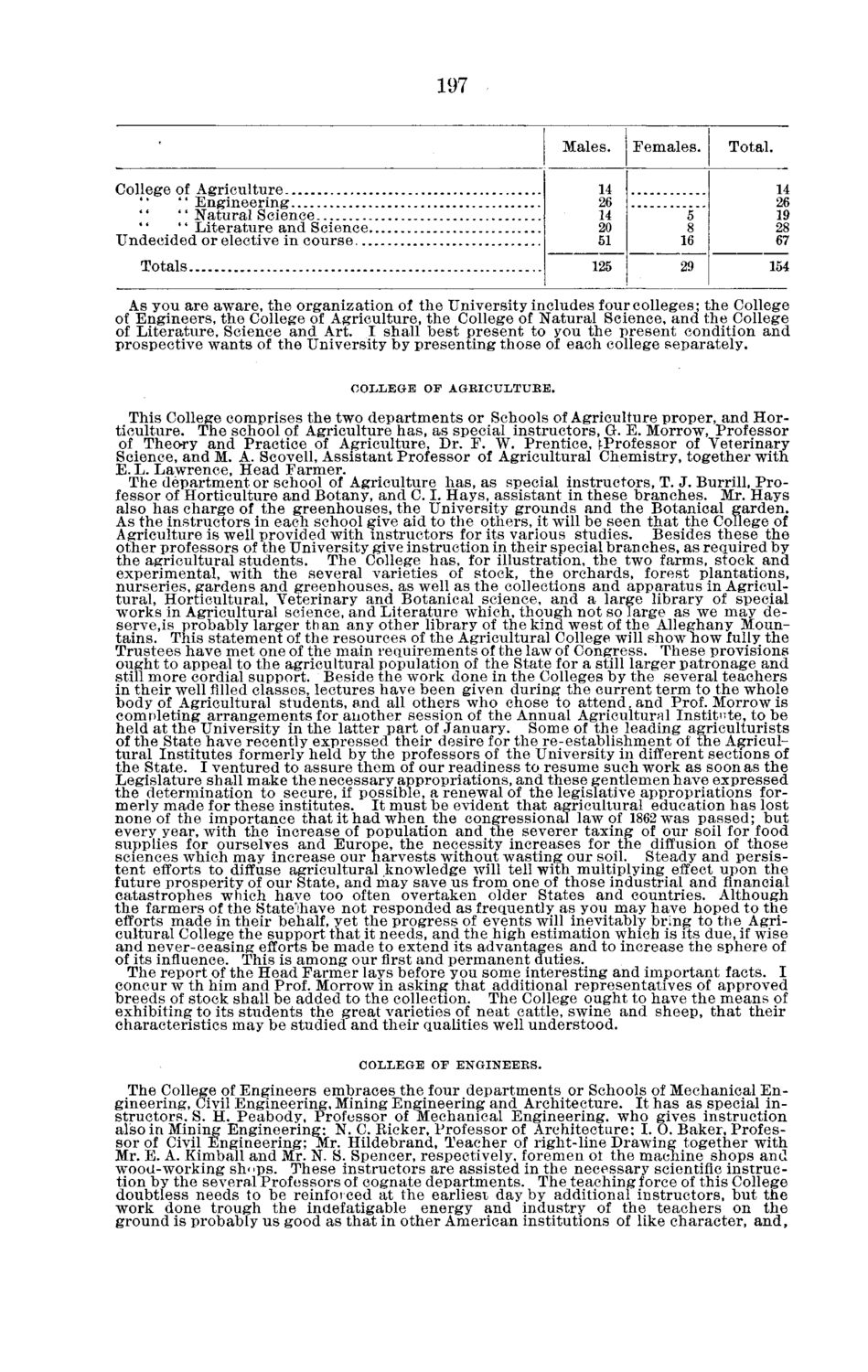| |
| |
Caption: Board of Trustees Minutes - 1880
This is a reduced-resolution page image for fast online browsing.

EXTRACTED TEXT FROM PAGE:
197 Males. College of A g r i c u l t u r e " " Engineering " " N a t u r a l Science " " L i t e r a t u r e a n d Science U n d e c i d e d or elective in c o u r s e Totals 14 26 14 20 51 125 Females. Total. 14 26 19 28 67 154 5 8 16 29 As you are aware, the organization of the University includes four colleges; the College of Engineers, the College of Agriculture, the College of Natural Science, and the College of Literature, Science and Art. I shall best present to you the present condition and prospective wants of the University by presenting those of each college separately. COLLEGE OF AGRICULTURE. This College comprises the two departments or Schools of Agriculture proper, and Horticulture. The school of Agriculture has, as special instructors, G. E. Morrow, Professor of Theory and Practice of Agriculture, Dr. F. W. Prentice, f-Professor of Veterinary Science, and M. A. Scovell, Assistant Professor of Agricultural Chemistry, together with E. L. Lawrence, Head Farmer. The department or school of Agriculture has, as special instructors, T. J. Burrill, Professor of Horticulture and Botany, and C. I. Hays, assistant in these branches. Mr. Hays also has charge of the greenhouses, the University grounds and the Botanical garden. As the instructors in each school give aid to the others, it will be seen that the College of Agriculture is well provided with instructors for its various studies. Besides these the other professors of the University give instruction in their special branches, as required by the agricultural students. The College has, for illustration, the two farms, stock and experimental, with the several varieties of stock, the orchards, forest plantations, nurseries, gardens and greenhouses, as well as the collections and apparatus in Agricultural, Horticultural, Veterinary and Botanical science, and a large library of special works in Agricultural science, and Literature which, though not so large as we may deserve,is probably larger than any other library of the kind west of the Alleghany Mountains. This statement of the resources of the Agricultural College will show now fully the Trustees have met one of the main requirements of the law of Congress. These provisions ought to appeal to the agricultural population of the State for a still larger patronage and still more cordial support. Beside the work done in the Colleges by the several teachers in their well filled classes, lectures have been given during the current term to the whole body of Agricultural students, and all others who chose to attend, and Prof. Morrow is completing arrangements for another session of the Annual Agricultural Institute, to be held at the University in the latter part of January. Some of the leading agriculturists of the State have recently expressed their desire for the re-establishment of the Agricultural Institutes formerly held by the professors of the University in different sections of the State. I ventured to assure them of our readiness to resume such work as soon as the Legislature shall make the necessary appropriations, and these gentlemen have expressed the determination to secure, if possible, a renewal of the legislative appropriations formerly made for these institutes. It must be evident that agricultural education has lost none of the importance that it had when the congressional law of 1862 was passed; but every year, with the increase of population and the severer taxing of our soil for food supplies for ourselves and Europe, the necessity increases for the diffusion of those sciences which may increase our harvests without wasting our soil. Steady and persistent efforts to diffuse agricultural knowledge will tell with multiplying effect upon the future prosperity of our State, and may save us from one of those industrial and financial catastrophes which have too often overtaken older States and countries. Although the farmers of the Stateihave not responded as frequently as you may have hoped to the efforts made in their behalf, yet the progress of events will inevitably bring to the Agricultural College the support that it needs, and the high estimation which is its due, if wise and never-ceasing efforts be made to extend its advantages and to increase the sphere of of its influence. This is among our first and permanent duties. The report of the Head Farmer lays before you some interesting and important facts. I concur w th him and Prof. Morrow in asking that additional representatives of approved breeds of stock shall be added to the collection. The College ought to have the means of exhibiting to its students the great varieties of neat cattle, swine and sheep, that their characteristics may be studied and their qualities well understood. COLLEGE OF ENGINEEES. The College of Engineers embraces the four departments or Schools of Mechanical Engineering, Civil Engineering, Mining Engineering and Architecture. It has as special instructors, S. H. Peabody, Professor of Mechanical Engineering, who gives instruction also in Mining Engineering; N. C. Bicker, Professor of Architecture; I. O. Baker, Professor of Civil Engineering; Mr. Hildebrand, Teacher of right-line Drawing together with Mr. E. A. Kimball and Mr. N. S. Spencer, respectively, foremen ot the machine shops and wood-working sh"ps. These instructors are assisted in the necessary scientific instruction by the several Professors of cognate departments. The teaching force of this College doubtless needs to be reinforced at the earliest day by additional instructors, but the work done trough the indefatigable energy and industry of the teachers on the ground is probably us good as that in other American institutions of like character, and,
| |